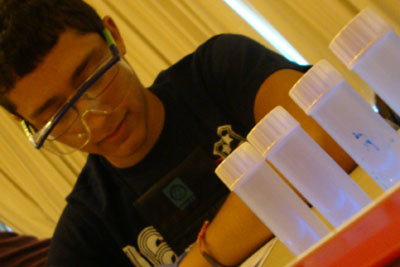Engage in AccessSTEM


Request and encourage student input on how to best accommodate the student's learning needs.
Establish and honor classroom schedules and practices. Let the student know ahead of time of any changes to the classroom routines.
In group activities, assign the student to a group with supportive peers. Provide clear instructions so that students know exactly what is expected of them.
Help the student learn to anticipate situations that will be difficult and to plan in advance appropriate response strategies.
Request and encourage student input on how to best accommodate the student's learning needs.
Assure that classrooms and labs are in wheelchair-accessible locations.
Use an adjustable table, and locate lab equipment within reach.
Request and encourage student input on how to best accommodate the student's learning needs.
Consider the position, lighting, and seating needs of the student during presentations or when using text, manipulatives, transparencies or other projected images.
Provide large-print lecture notes, handouts, and worksheets.
Orient the student to the classroom (dimensions, exits, furniture arrangement, hazards) initially and whenever a change occurs.
Request and encourage student input on how to best accommodate the student's learning needs.
A computer with voice output software is an appropriate accommodation for students with learning disabilities. Consult the video presentation and publication Working Together: Computers and People with Learning Disabilities and the AccessSTEM Knowledge Base.
Request and encourage student input on how to best accommodate the student's learning needs.
Provide a sign language interpreter, real-time captioning, and/or an FM system.
Provide access to an open- or closed-captioned film.
Use visual aids to explain concepts to the student.
Face students with hearing impairments so that they can see your lips. Speak clearly. Repeat questions or comments from others.
Allow flexible seating to provide a clear view of a sign language interpreter, lip reading, visual aids, and demonstrations.
Request and encourage student input on how to best accommodate the student's learning needs.
Provide a mechanism for students to learn material and make up assignments that they missed because of absences.
Provide flexibility in scheduling and attendance.
Talk with the student and family about any impacts of class activities on the student. Let the student know well ahead of time of classroom activities that may present a problem.
Request and encourage student input on how to best accommodate the student's learning needs.
Provide audiotaped, Brailled, or electronic-formatted lecture notes, handouts, and texts.
Give clear verbal descriptions of visual aids including video and printed content used throughout your presentation.
To find calculators for students who are blind, consult the National Federation of the Blind Independence Market Online or American Printing House for the Blind.
Request and encourage student input on how to best accommodate the student's learning needs.